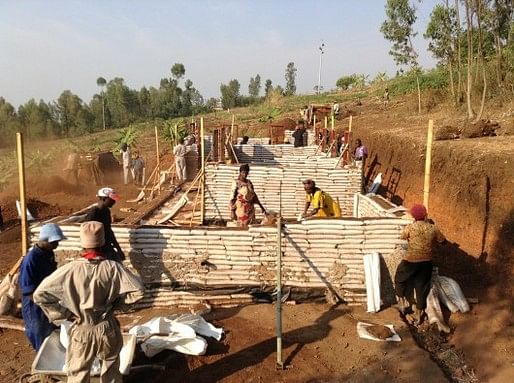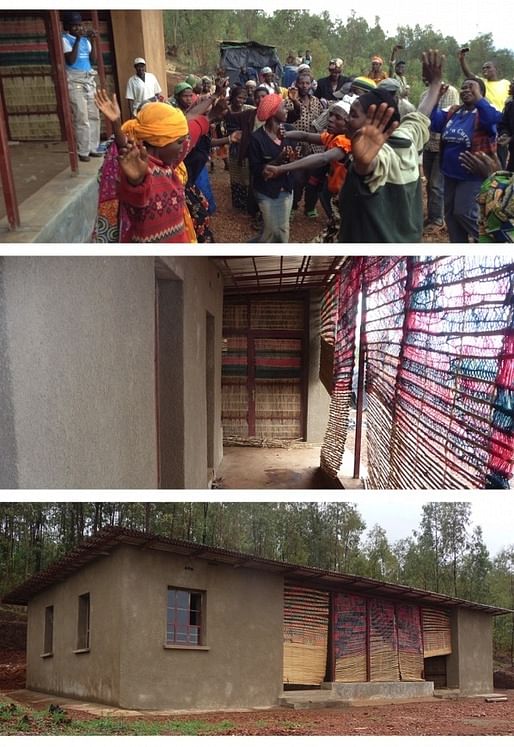
Yutaka Sho has been working on housing redevelopment strategies in Rwanda since 2008, and from the beginning the challenges were clear. Building materials were severely limited and ripple effects from the 1994 genocide were still strong, leaving Rwandan society displaced and disproportionately female. After the genocide, the Rwandan government enacted the controversial "imidugudu" development strategy; a "villagization" program that tried to gather rural homesteads together in villages, to make it easier to deliver resources. Even more Rwandans were displaced as a result, and often did not receive the promised resources.*
Sho's work with the GAC is to aid reconstruction without further disrupting Rwandans' lives. They partnered with Dushyigikirane, a women's organization in the northern Rwandan town of Masoro, to help the community build their own housing so they wouldn't be forcibly relocated. GAC would help Dushyigikirane in designing the new village of 50 houses, using the accessible and teachable EarthBag construction method, where ubiquitous polypropylene bags are stuffed with dirt and used as building blocks.


Last summer, GAC held EarthBag construction workshops for 50 villagers, and is now focused on ensuring that locals have the momentum to continue redevelopment independently.** Yutaka Sho and her GAC partner James Setzler connected with Archinect to update us on their work in Masoro, and the difficulties of pitching long-term projects to NGOs.
Amelia Taylor-Hochberg: Describe the current status of GAC's work in Rwanda.
Yutaka Sho and James Setzler: The nature of our work has recently undergone a shift. While building the first home in Masoro in the summer of 2013, the participating villagers established a builders’ association called Icyerekezo, or “New Vision”. We at GAC are pivoting our involvement, so that the new association is able to take the lead on future projects to construct and teach EarthBag buildings. Their first project as a professional association is to build a small mixed-use structure that will act as an office, storage and information center for their own use. The storage building will allow us to stockpile materials, saving time and money. GAC is in the process of designing and raising funds for this structure; to date we have about half of what we will need. In the future, we see ourselves evolving as enablers, facilitating the agency to build buildings, rather than overseeing projects in the traditional role of design professionals.
AT-H: What has been most difficult concerning fundraising?
YS/JS: When the project began, Yutaka visited many NGOs (nongovernmental organizations) in Rwanda asking for donations. Quickly we realized that many of them do not like to fund buildings, and would rather support projects that demonstrate immediate and public impact. Buildings require long-term maintenance commitments. What donors perhaps do not appreciate is that in Rwanda, public speech is censored and the private home is one of the only spaces left that may host open conversations. Funding housing means funding public engagement in Rwanda, but we failed to convince them with that concept. Yutaka has also lobbied with government ministries but they expected us (the Westerners) to bring in the money. So instead, we are experimenting with alternate methods of fundraising using our design skills such as the StitchWorks project.

More importantly, however, when fundraising, we are careful not to cast our clients as weak people in need of help. It is true that many of them lack basic necessities such as water, food, healthcare services and shelter. Descriptions of poverty are easy to communicate with Western donors and effective in fund raising, and we certainly hope to alleviate such hardships through our work. But our agenda is not charity. Using architecture, we investigate how the right to space can be achieved by underrepresented peoples by promoting political voices as much as economic independence. The issue is cumbersome to explain when a catch phrase is more likely to bring results when fund raising. But through every step of design we hope to engage in discussions with our audience, both in the West and in Africa, to question economic and political discrepancies. The challenge is to communicate the urgency that drives our work without being righteous or preachy.
AT-H: Describe your collaboration process and style with the women's groups.
YS/JS: Our collaborative goals are to engage our clients as equal partners, and involve as many local partners as we can to ensure the project’s success. Finding the right association was the first step. Our first partner association, Dushygikirane, with whom we worked before the birth of New Vision, had already built a village in 1997. So we were confident that they would prove an able partner. We also engaged local authorities, though with mixed success. Our most important collaborative success was working with local architecture students who engaged the villager-workers in ways that we never could. They quickly became the true face of the project. By integrating future architects into the design and construction process, we hope that the new material and technique will be incorporated into the Rwandan architectural discipline.
Key also to the collaboration was the nature of the construction. By designing the building as a low-skilled endeavor centered around a hands-on, everyone-welcome style of building workshop, villagers, students, and Western designers alike earned a stake in the success of the house, and acquired skills unique in the country.
AT-H: Do you plan on maintaining a presence in Rwanda/Masoro, after the project has completed its goal of 50 houses?
YS/JS: Yes, we certainly plan to remain in Rwanda. As expressed above, GAC’s aim is not only to build but also to investigate global building cultures using our projects as case studies. Collaborative relationships improve with time and trust, and we hope take further advantage of the specific regional knowledge we’ve begun to amass.

Sources
No Comments
Block this user
Are you sure you want to block this user and hide all related comments throughout the site?
Archinect
This is your first comment on Archinect. Your comment will be visible once approved.